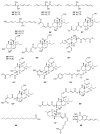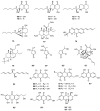Structures and Biological Activities of Secondary Metabolites from Trichoderma harzianum
- PMID: 36355024
- PMCID: PMC9696559
- DOI: 10.3390/md20110701
Structures and Biological Activities of Secondary Metabolites from Trichoderma harzianum
Abstract
The biocontrol fungus Trichoderma harzianum, from both marine and terrestrial environments, has attracted considerable attention. T. harzianum has a tremendous potential to produce a variety of bioactive secondary metabolites (SMs), which are an important source of new herbicides and antibiotics. This review prioritizes the SMs of T. harzianum from 1988 to June 2022, and their relevant biological activities. Marine-derived SMs, especially terpenoids, polyketides, and macrolides compounds, occupy a significant proportion of natural products from T. harzianum, deserving more of our attention.
Keywords: Trichoderma harzianum; bioactivity; marine sources; natural products; secondary metabolites.
Conflict of interest statement
The authors declare no conflict of interest.
Figures










Similar articles
-
New acorane-sesequiterpenes and anti-retinoblastoma constituents from the marine algicolous fungus Trichoderma harzianum NTU2180 guided by molecular networking strategy.Bot Stud. 2025 Jan 14;66(1):2. doi: 10.1186/s40529-024-00449-5. Bot Stud. 2025. PMID: 39808245 Free PMC article.
-
ThpacC Acts as a Positive Regulator of Homodimericin A Biosynthesis and Antifungal Activities of Trichoderma harzianum 3.9236.J Agric Food Chem. 2021 Nov 3;69(43):12695-12704. doi: 10.1021/acs.jafc.1c04330. Epub 2021 Oct 22. J Agric Food Chem. 2021. PMID: 34677054
-
New Polyketides From Trichoderma harzianum and Their Antifungal Activity.Chem Biodivers. 2025 Jun;22(6):e202500140. doi: 10.1002/cbdv.202500140. Epub 2025 Feb 6. Chem Biodivers. 2025. PMID: 39913892
-
Structures and Biological Activities of Secondary Metabolites from the Trichoderma genus (Covering 2018-2022).J Agric Food Chem. 2023 Sep 20;71(37):13612-13632. doi: 10.1021/acs.jafc.3c04540. Epub 2023 Sep 8. J Agric Food Chem. 2023. PMID: 37684097 Review.
-
Marine-derived Trichoderma Species as a Promising Source of Bioactive Secondary Metabolites.Mini Rev Med Chem. 2018;18(20):1702-1713. doi: 10.2174/1389557518666180727130826. Mini Rev Med Chem. 2018. PMID: 30051788 Review.
Cited by
-
Mechanisms and Impact of Rhizosphere Microbial Metabolites on Crop Health, Traits, Functional Components: A Comprehensive Review.Molecules. 2024 Dec 15;29(24):5922. doi: 10.3390/molecules29245922. Molecules. 2024. PMID: 39770010 Free PMC article. Review.
-
The Polyketides with Antimicrobial Activities from a Mangrove Endophytic Fungus Trichoderma lentiforme ML-P8-2.Mar Drugs. 2023 Oct 28;21(11):566. doi: 10.3390/md21110566. Mar Drugs. 2023. PMID: 37999390 Free PMC article.
-
Exploration and Evaluation of Secondary Metabolites from Trichoderma harzianum: GC-MS Analysis, Phytochemical Profiling, Antifungal and Antioxidant Activity Assessment.Molecules. 2023 Jun 27;28(13):5025. doi: 10.3390/molecules28135025. Molecules. 2023. PMID: 37446686 Free PMC article.
-
Unraveling the metabolic potential of biocontrol fungi through omics data: a key to enhancing large-scaleapplication strategies.Acta Biochim Biophys Sin (Shanghai). 2024 Jun 25;56(6):825-832. doi: 10.3724/abbs.2024056. Acta Biochim Biophys Sin (Shanghai). 2024. PMID: 38686460 Free PMC article. Review.
-
Identification of Secondary Metabolites by UHPLC-ESI-HRMS/MS in Antifungal Strain Trichoderma harzianum (LBAT-53).J Fungi (Basel). 2024 Aug 3;10(8):547. doi: 10.3390/jof10080547. J Fungi (Basel). 2024. PMID: 39194873 Free PMC article.
References
Publication types
MeSH terms
Supplementary concepts
Grants and funding
LinkOut - more resources
Full Text Sources

